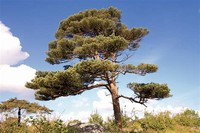Facts about Pine

Eastern white pine is the provincial tree of Ontario, Canada, and the state tree of Maine and Michigan and its "pine cone and tassel" is the "state flower" of Maine.

Pinetums (or pineta) botanical gardens, especially dedicated to various pines, were first established in England and the United States in the 1800s.

Pines are commercially among the most important of species used for timber in temperate regions of the world.

Some pines are used for Christmas trees, and pine cones are also widely used for Christmas decorations.

The seeds of some pines are a good food source and have been important especially in the Mediterranean region and in southwestern North America.

Many pines are also very attractive ornamental trees planted in parks, large gardens, and so forth.

The sugar pine has been severely affected by the White Pine Blister Rust (Cronartium ribicola), a fungus that was accidentally introduced from Europe in 1909.

White pine forests originally covered much of northeastern North America, though few of the original trees remain untouched by the extensive logging operations in the 1700s and 1800s.

The United States Forest Service has a program for developing rust-resistant sugar pine and western white pine.

Stone Pines are still valued by humans for their seeds but now more are grown as ornamentals.

Pines are found naturally only in the Northern Hemisphere (with one very minor exception) where their forests dominate vast areas of land.

The pines have oils that transpirate through their needle stomata and evaporate from sap resin in wounds and growing cones which provides a pleasant fragrance unmatched by other genera.

The Great Basin bristlecone pine grows only in a few mountain ranges in eastern California, Utah, and Nevada and only at high elevations of 2,600-3,550 meters (8,500-11,650 feet) (Lanner 1999).

The Stone Pine (Pinus pinea) was named by Carolus Linnaeus as the "pine of pines" (Peterson 1980).

The bark of most pines is thick and scaly, but some species have thin, flaking bark.

The inner bark of many pine trees can also be eaten, mostly in times of famine or emergency.

The sugar pine (Pinus lambertiana) is the largest pine, commonly growing 40-60 meters (130-200 feet) tall and sometimes as tall as 80 meters (260 feet) or even more.

Some pines are used for Christmas trees, and pine cones are also widely used for Christmas decorations.

The Scots Pine (Pinus sylvestris) has the widest distribution of any pine, growing wild across northern Europe and Asia from the Atlantic Ocean to the Pacific Ocean.

The Japanese Red Pine (Pinus densiflora) has a home range that includes Japan, Korea, northeastern China, and the extreme southeast of Russia.

The growth rings of Great Basin bristlecone pines have been studied as a way of dating objects from the past and to study past climate changes.

Pines are mostly monoecious, having the male and female cones on the same tree.

One survivor is a specimen known as the "Boogerman Pine" in the Cataloochee Valley, Great Smoky Mountains National Park.

The rust has also destroyed much of the western white pine and whitebark pine outside of California.

